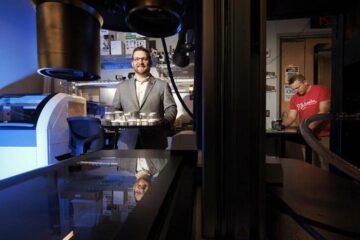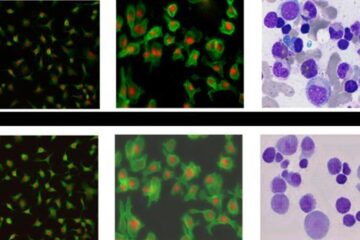Nerve Cells’ Powerhouse "Clogged" in Lou Gehrig’s Disease

By studying rodent models of the relatively rare inherited form of Lou Gehrig’s disease and tissue samples from a patient with the condition, scientists have discovered the first evidence that damage to nerve cell powerhouses is directly responsible for these cells’ death. The findings appear in the July 9 issue of Neuron.
The research team from the University of California San Diego, Johns Hopkins and elsewhere discovered that dysfunctional proteins clog the transport system that brings vital substances into mitochondria, the tiny organelles that provide energy to cells. This mitochondrial damage occurs in muscle-controlling nerve cells, the researchers report, helping explain the selective nature of inherited amyotrophic lateral sclerosis (ALS), or Lou Gehrig’s disease.
“Mitochondria don’t look normal in motor neurons in animal models of ALS and in patients with ALS, but this is the first study that links ALS and a specific problem with the mitochondria,” says study co-author Jeffrey Rothstein, M.D., Ph.D., professor of neurology and director of the Robert Packard Center for ALS Research at Johns Hopkins.
The discovery provides new avenues to try to prevent or treat the progressive, fatal condition, say the researchers, and creates the possibility that mitochondria also might be involved in the more common forms of ALS or in other neurodegenerative diseases.
Inherited ALS, which accounts for less than 5 percent of ALS cases, is caused by a number of different mutations in the gene for superoxide dismutase, or SOD1, an enzyme that normally helps clean toxic molecules from cells. Each group of mice and rats studied by the researchers had been engineered to carry one of these mutations.
By studying whole mitochondria purified from the brain, spinal cord and other tissues from the mice and rats, and a variety of samples taken from an ALS patient at autopsy, the researchers discovered that the outer mitochondrial surface was clogged with mutant SOD1 protein in spinal cord nerve cells but not in other tissues.
“In essence, the proteins literally gum up the works,” says the study’s leader, Don Cleveland, Ph.D., a scientist at UCSD and a researcher in the Packard Center.
The researchers suggest that the “works” for mitochondria in muscle-controlling nerves might be different from that in other cells. That uniqueness could explain why only the motor neurons’ mitochondria are damaged and only those cells die, even though every cell in a rat, mouse or person with inherited ALS carries the instructions for the mutant SOD1.
“We’re viewing mitochondrial involvement as the greatest insult to the spinal cord cells in this form of ALS,” Cleveland says. “We believe it’s what pushes them over the edge.”
The damaged mitochondria cause many problems and push the cell irreversibly toward death. “We’ve long known, for example, that having abnormal mitochondria makes neurons susceptible to injury from an excess of the chemical transmitter glutamate,” says Rothstein, who notes that glutamate toxicity is a well-recognized aspect of ALS.
The scientists are beginning to test the potential role of mitochondrial involvement in the more common, sporadic forms of ALS and to try to target cell death and toxicity that stem from mitochondrial damage.
The study was funded by the U.S. National Institutes of Health, the Packard Center for ALS Research at Johns Hopkins, the Spinal Cord Foundation, the Bjorklund Foundation for ALS Research and the Paralyzed Veterans of America Spinal Cord Research Foundation.
Authors on this paper are Cleveland, Jian Liu, Concepcion Lillo, Christine Velde, Christopher Ward, Timothy Miller and David Williams of UCSD; Rothstein, Jamuna Subramaniam and Philip Wong of Johns Hopkins (Wong is also with the Packard Center); P. Andreas Jonsson, Peter Andersen, Stefan Marklund and Thomas Brannstrom at Umea University in Sweden; and Ole Gredal of the Bispebjerg Hospital in Copenhagen, Denmark.
Media Contact
All latest news from the category: Life Sciences and Chemistry
Articles and reports from the Life Sciences and chemistry area deal with applied and basic research into modern biology, chemistry and human medicine.
Valuable information can be found on a range of life sciences fields including bacteriology, biochemistry, bionics, bioinformatics, biophysics, biotechnology, genetics, geobotany, human biology, marine biology, microbiology, molecular biology, cellular biology, zoology, bioinorganic chemistry, microchemistry and environmental chemistry.
Newest articles

Bringing bio-inspired robots to life
Nebraska researcher Eric Markvicka gets NSF CAREER Award to pursue manufacture of novel materials for soft robotics and stretchable electronics. Engineers are increasingly eager to develop robots that mimic the…

Bella moths use poison to attract mates
Scientists are closer to finding out how. Pyrrolizidine alkaloids are as bitter and toxic as they are hard to pronounce. They’re produced by several different types of plants and are…

AI tool creates ‘synthetic’ images of cells
…for enhanced microscopy analysis. Observing individual cells through microscopes can reveal a range of important cell biological phenomena that frequently play a role in human diseases, but the process of…





















